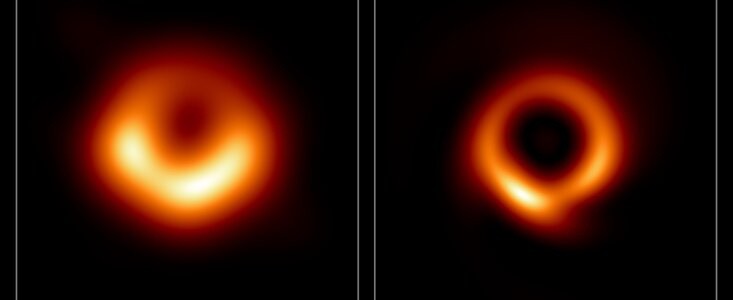The iconic image of the supermassive black hole at the center of Messier 87 that broke the Internet in 2019 has become sharper than ever, thanks to artificial intelligence!
A team of researchers, including an astronomer with NSF's NOIRLab, enhanced the image using a new machine-learning technique called PRIMO.

PRIMO Sharpens the Black Hole
The researchers used the original 2017 data from the Event Horizon Telescope (EHT) collaboration. They created a new image that represents the full resolution of the EHT, resulting in a sharper and more detailed picture of the black hole.
EHT members Lia Medeiros, Dimitrios Psaltis, Tod Lauer, and Feryal Ozel developed a machine-learning technique called PRIMO, which stands for principal-component interferometric modeling.
PRIMO uses dictionary learning to fill in gaps in data collected by the EHT's network of seven radio telescopes located in various parts of the world.
Over 30,000 high-fidelity simulated images of gas accreting onto a black hole were examined using PRIMO to hunt for patterns that could be combined to create an extremely realistic depiction of the EHT observations.
The image produced is more accurate in capturing the whole size of the black hole's dense center region as well as the remarkably narrow outer ring, which is now around a factor of two smaller, according to the team.
Additionally, it allows scientists to further tighten the limitations on alternatives for the event horizon and conduct more reliable gravity tests.
The new image was also compatible with the EHT data and theoretical predictions, including the bright ring of emission anticipated by hot gas falling into the black hole.
New Approach to Constructing Images
PRIMO can also be used to analyze more EHT data, such as data from Sagittarius A*, the galaxy's central black hole.
"PRIMO is a new approach to the difficult task of constructing images from EHT observations," Tod Lauer of NSF's NOIRLab said in a press release statement.
"It provides a way to compensate for the missing information about the object being observed, which is required to generate the image that would have been seen using a single gigantic radio telescope the size of the Earth."
The enhanced image of the black hole at the center of Messier 87 demonstrates the power of PRIMO, which can potentially be applied to other fields beyond astronomy, showcasing the potential of machine learning in advancing our understanding of the universe.
The researchers' work is published in The Astrophysical Journal Letters, with a paper describing the algorithm itself detailed previously in The Astrophysical Journal on February 3, 2023.
Related Article : Albert Einstein's Theory of General Relativity Prediction Happens: Light Behind Black Hole Detected by Telescopes

![Apple Watch Series 10 [GPS 42mm]](https://d.techtimes.com/en/full/453899/apple-watch-series-10-gps-42mm.jpg?w=184&h=103&f=9fb3c2ea2db928c663d1d2eadbcb3e52)



